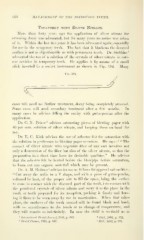Page 670 - My FlipBook
P. 670
'
668 MANAGEMENT OF THE DECIDUOUS TEETH.
Treatment with Silver Nitrate.
More than forty years ago tlic application of silver nitrate for
arresting decay was advocated, but for many years no notice was taken
of it. Within the last five years it has been advocated again, especially
for use in the temporary teeth. The fact that it blackens the decayed
surface is not as objectionable as with permanent teeth. Dr. Stebbins
advocated the use of a solution of the crystals of silver nitrate in cari-
ous (cavities in temporary teeth. He applies it by means of a small
stick inserted in a socket instrument as shown in Fig. 594. Many
Fig. 594.
cases will need no further treatment, decay being completely arrested.
Some cases will need secondary treatment after a few months. In
many cases he advises filling the cavity with gutta-percha after the
application.
Dr. C. N. Peirce^ advises saturating pieces of blotting paper with
40 per cent, solution of silver nitrate, and keeping these on hand for
use.
Dr. E. C. Kirk advises the use of asbestos felt for saturation with
the solution in preference to blotting paper or cotton. He says :^ " The
contact of silver nitrate with vegetable fiber of any sort involves not
only a destruction of the fiber but also of the silver nitrate, so that the
preparation in a short time loses its desirable qualities." He advises
that the asbestos felt be heated before the blowpipe before saturation^
to burn out any organic material which may be present.
Dr. A. M. Holmes "* advises its use as follows for approximal cavities :
" Cut away the walls to a V shape, and with a piece of gutta-percha,
softened by heat, of the proper size to fill the space, bring the surface
to come in contact with the diseased part of the teeth, into contact with
the powdered crystals of silver nitrate and carry it to the place in the
tooth or teeth prepared for its reception, packing it firmly and leav-
ing it there to be worn away by use in mastication. When that takes
place, the surfaces of the teeth treated will be found black and hard,
with no sensitiveness to the touch or to change of temperature, and
they will remain so indefinitely. In case the child is so timid as to
1 International Dental Journal, 1891, p. 661. ^ Ibid., 1893, p. 152.
3 Dental Cos7nos, 1893, p. 667. * Ibid., 1892, p. 982.
668 MANAGEMENT OF THE DECIDUOUS TEETH.
Treatment with Silver Nitrate.
More than forty years ago tlic application of silver nitrate for
arresting decay was advocated, but for many years no notice was taken
of it. Within the last five years it has been advocated again, especially
for use in the temporary teeth. The fact that it blackens the decayed
surface is not as objectionable as with permanent teeth. Dr. Stebbins
advocated the use of a solution of the crystals of silver nitrate in cari-
ous (cavities in temporary teeth. He applies it by means of a small
stick inserted in a socket instrument as shown in Fig. 594. Many
Fig. 594.
cases will need no further treatment, decay being completely arrested.
Some cases will need secondary treatment after a few months. In
many cases he advises filling the cavity with gutta-percha after the
application.
Dr. C. N. Peirce^ advises saturating pieces of blotting paper with
40 per cent, solution of silver nitrate, and keeping these on hand for
use.
Dr. E. C. Kirk advises the use of asbestos felt for saturation with
the solution in preference to blotting paper or cotton. He says :^ " The
contact of silver nitrate with vegetable fiber of any sort involves not
only a destruction of the fiber but also of the silver nitrate, so that the
preparation in a short time loses its desirable qualities." He advises
that the asbestos felt be heated before the blowpipe before saturation^
to burn out any organic material which may be present.
Dr. A. M. Holmes "* advises its use as follows for approximal cavities :
" Cut away the walls to a V shape, and with a piece of gutta-percha,
softened by heat, of the proper size to fill the space, bring the surface
to come in contact with the diseased part of the teeth, into contact with
the powdered crystals of silver nitrate and carry it to the place in the
tooth or teeth prepared for its reception, packing it firmly and leav-
ing it there to be worn away by use in mastication. When that takes
place, the surfaces of the teeth treated will be found black and hard,
with no sensitiveness to the touch or to change of temperature, and
they will remain so indefinitely. In case the child is so timid as to
1 International Dental Journal, 1891, p. 661. ^ Ibid., 1893, p. 152.
3 Dental Cos7nos, 1893, p. 667. * Ibid., 1892, p. 982.


